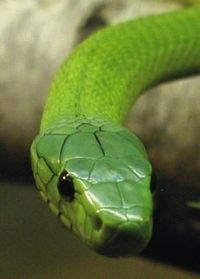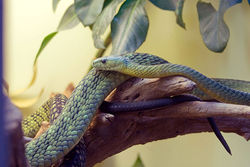Jameson's mamba
| Jameson's mamba | ||||||||||||||||||||
|---|---|---|---|---|---|---|---|---|---|---|---|---|---|---|---|---|---|---|---|---|
 Jameson's mamba
| ||||||||||||||||||||
| Scientific classification | ||||||||||||||||||||
| ||||||||||||||||||||
| Binomial name | ||||||||||||||||||||
| Dendroaspis jamesoni (Traill, 1849)[1][2] | ||||||||||||||||||||
 Distribution of D. j. jamesoni and D. j. kaimosae
| ||||||||||||||||||||
| Synonyms | ||||||||||||||||||||
|
Dendroaspis jamesoni jamesoni
Dendroaspis jamesoni kaimosae
|
The Jameson's mamba (Dendroaspis jamesoni), also known as Traill's green mamba and Jameson's green mamba, is a quick, highly arboreal and highly venomous species of snake native to Africa. It belongs to the genus Dendroaspis and the family Elapidae. The species has two subspecies, the nominate subspecies Dendroaspis jamesoni jamesoni, which will be the main subspecies described in this article, and the second subspecies Dendroaspis jamesoni kaimosae. In describing the nominate subspecies, the second subspecies D. j. kaimosae will also be described as they are both very similar snakes. The main difference between the two subspecies are the scalation and geographical distribution. D. j. kaimosae occurs in the eastern part of this species' geographical range, which is why it is called the East African Jameson's mamba.
Etymology
The Jameson's mamba was first described by Traill in 1849.[3] The genus name is derived from the Ancient Greek word - Dendroaspis meaning "tree asp" (dendro is "tree", while aspis is "asp" which is understood to mean a "venomous snake") and the etymology of the name "jamesoni" is unknown.
Description
This species is a long, slightly compressed, very slender bodied snake with a medium length tapering tail that is often yellow in colour.[4][5] This large and arboreal snake have a average length of 1.5 m (4.92 ft) to 2.2 m (7.22 ft), but they can grow up to 2.7 m (8.86 ft) and around 20-30% of the total length is the tail.[4]Males tend to be significantly longer than females. Luiselli et al conducted a study in Nigeria and they measured the total length of 22 males and 27 females. There was considerable sexual size dimorphism: the males (x_ = 1.66 m (5.45 ft), SD = 25.9) attained much larger sizes than the females (x = 1.47 m (4.82 ft), SD = 20.3) (Student t-test: t = 2.95, df = 47, P = 0.0049). The maximum length attained by males was 2.12 m (6.96 ft), and the maximum length attained by females was 1.75 m (5.74 ft).[6] They tend to be very similar to the Western green mamba in colouration and like the Western green mamba, the scales of the body of this species have black edgings as well. They are usually a dark green, but lighter yellowish green specimens are also common. The ventral side is usually either pale green or yellowish in colour.[5] Jameson's mamba's have a narrow and elongated head is, with a distinct canthus and slightly distinct from the neck. Like the Western green mamba, the neck may be flattened when the snake is aroused, but there is no real hood. The eyes are medium in size with round pupils. Dorsal scales are oblique, smooth and narrow.[4]
Scalation
Dendroaspis jamesoni jamesoni:
Dorsal scales at midbody 15-19, Ventrals 210-235, Subcaudals 94-122, Subcaudals are Paired, Anal plate is Divided, Upper labials 7-9, Preoculairs 3, Postoculairs 3, Lower labials 8-10, Temporales 2+1 variable.
Dendroaspis jamesoni kaimosae:
Dorsal scales at midbody 15-19, Ventrals 209-227, Subcaudals 94-113, Subcaudals are Paired, Anal plate is Divided, Upper labials 7-9, Preoculairs 3, Postoculairs 3-5, Lower labials 9-11, Temporales 2+3 variable.
Distribution and habitat
Geographical distribution
The Jameson's mamba occurs mostly in central Africa and some parts of eastern Africa and western Africa. They can be found all the way from northern Angola eastwards towards Zambia, north to the Democratic Republic of Congo, Republic of Congo, Uganda, Rwanda, Kenya, Burundi, South Sudan, Sudan, Central African Republic, Cameroon, Gabon, Ghana, Togo, Nigeria, and Equatorial Guinea.[7]
Habitat
Jamesons mambas are strictly arboreal snakes. They can be found in forests, woodland, defrosted areas, mosaic thicket and forest-savannas. They can be found anywhere from sea level up to 2200 m (7217.85 ft) above sea level. Jamesons mambas are known to be found in city parks and buildings when there natural habitat is destroyed. They can also been found at farms and plantations. It seems that this species inhabits a wide variety of habitats (including secondary forest patches and the plantation-forest mosaic), and that its local distribution is not influenced by the presence of any macrohabitat parameter.[4] In a study done by Luiselli et al, these snakes were found in secondary dry forest (n = 22, 26.5% of the total sample observed), primary dry forest (n = 10, 12%), primary swamp forest (n = 19, 22.9%), mangrove formations (n = 2, 2.4%), bushy spots in the forest-plantation mosaic (n = 3, 3.6%), farms and plantations (n = 23, 27.7%), and suburban areas (n = 4, 4.8%). As for the preserved specimens observed in high school and hospital collections (n = 11), it was impossible to establish the habitat of capture. However, based on interviews with school personnel, it is likely that these specimens came from highly disturbed areas around towns (suburbia and plantations). An adult roadkilled male was found in a business part of Port Harcourt city (“Mile two Diobu”), where only a few bushes and trees surrounding a wide grassy field were available to snakes.[6]
Behaviour and ecology
Behaviour and habits
This species is highly arboreal, more so than any other mamba species, descending to the ground only in pursuit of prey. Like other mamba's, they are diurnal.[4] Jameson's mamba, like other mamba species, will try to use their speed to quickly flee from a perceived threat or use their agility to out-maneuver a predator or a threat and then flee, usually high up in a tree. However, they are very alert, highly nervous and high strung snakes. Like any other mamba species, if the Jameson's mamba feels that it is cornered or if their threat is persistent, they will become very explosive and aggressive. They will lift their heads up off the ground, hiss loudly, and strike repeatedly.[8]
Diet
All adult jameson's mambas dietary records involve warm-blooded prey (mainly birds), whereas young Jameson's mambas fed also upon lizards and toads. Nearly all the prey eaten by adult Jameson's mambas were arboreal, and thus there was no support for the recent hypothesis that adult mambas develop an orientation to forage on terrestrial rodents. For dietary data 77 specimens (34 males, 29 females, 14 juveniles) were examined pooling together specimens captured alive in the field and specimens examined already dead. Identifiable food was found in 38.2% of the males, 13.8% of the females, and 28.6% of the juveniles, without any significant difference between wet and dry seasons (χ2 test, in all cases P > 0.1). Twenty-two specimens of D. jamesoni contained food in the guts; however, some individuals contained more than one prey item. From specimens shorter than 100 cm total length we removed 7 prey items, and from specimens longer than 100 cm we removed 27 prey items. Most snakes did not contain more than one prey category (i.e. birds and mammals, or birds and reptiles, etc), but a large male 208 cm long had one squirrel (Heliosciurus sp.) and one indetermined Passeriformes in the stomach. There was a positive correlation between log snake size (mass, in g) and log prey size (mass, in g) (Spearman’s r = 0.32, n = 20, P < 0.01), and the variance in prey size increased significantly with snake size (ANOVA: P < 0.05). Most adults over 100 cm fed almost exclusively on birds, while younger specimens under 100 cm in length feed mostly on other reptiles and on occasion amphibians.[6]
Reproduction
Luiselli et al found that combats between males and matings were observed during the dry season (December, January, and February), both on the ground and on the trees. Combats involved two individuals in four cases, and three individuals in a single case, and always occurred during the central daylight hours (11.15 to 15.50). Dissection of female snakes found dead in the field, in bush-meat markets of local people (cf. Akani et al., 1998), and in school collections provided data on the seasonal reproductive timing and on the clutch sizes. Gravid females were collected in April (n = 4), May (n = 6), and June (n = 5). One additional gravid female was captured in an unknown date. Adult females captured in other periods of the year (1 in February, 1 in March, 3 in May, 1 in July, 1 in September, 4 in November, and 1 in December) were not pregnant. The smallest female carrying eggs was 119 cm total length, and there was a highly significant positive correlation between maternal length and litter size. Luiselli et al did not collect data on the period of egg-laying in free-ranging green mambas. However, oviposition of four gravid specimens housed in an outdoor enclosure in Calabar (Cross River State) during 1998 occurred respectively on 6, 16, 28 June, and on 22 July. Oviposition of free-ranging specimens should most probably occur also between June and July. Mamba eggs were found in the field just three times (24 June 1997, 14 July 1997, and 2 July 1998). In all cases they were excavated by chance from holes in abandoned termite nests at forest clearings.[6]
Venom
Like other mamba's, the venom of the Jameson's mamba is an highly neurotoxic venom. It's other components include cardiotoxins,[9] and fasciculins.[4] In addition, this mamba species' venom may also have hemotoxic and myotoxic components to it.[10] The average venom yield per bite for this species is 80 mg, but some specimens may yield as much as 120 mg in a single bite. The subcutaneous LD50 for this species according to Brown (1973) is 1.0 mg/kg, while the intravenous LD50 is 0.8 mg/kg.[11] Envenomation by a Jameson's mamba can be deadly in as little as 30 to 120 minutes after being bitten, if proper medical treatment is not attained.[12] The mortality rate of untreated bites is not exactly known, but it's said to be very high.[4]
Subspecies
| Subspecies[1] | Taxon author[1] | Common name | Geographic range |
|---|---|---|---|
| D. j. jamesoni | (Traill, 1820) | Jameson's mamba | Throughout much of central Africa including Central African Republic, the Democratic Republic of the Congo, Ghana, Sudan, Gabon, Republic of Congo, Equatorial Guinea, Togo, and northern Angola |
| D. j. kaimosae | (Loveridge, 1936) | Black-tailed Jameson's mamba | Rwanda, Uganda, Kenya, Sudan, South Sudan, and eastern Democratic Republic of the Congo |
Cited references
- ↑ 1.0 1.1 1.2 Dendroaspis jamesoni (TSN 700482) at Integrated Taxonomic Information System. Accessed 21 May 2012.
- ↑ Dendroaspis jamesoni (TRAILL, 1843) at The Reptile Database. Accessed 21 May 2012.
- ↑ Traill 1843. Edinburgh new. phil. J., 34 (67): 54.
- ↑ 4.0 4.1 4.2 4.3 4.4 4.5 4.6 Dendroaspis jamesoni at Clinical Toxinology. Accessed 21 May 2012.
- ↑ 5.0 5.1 Africa's Venomous Snakes at South African Vaccine Producers. Accessed 21 May 2012.
- ↑ 6.0 6.1 6.2 6.3 Luca Luiselli , Francesco M. Angelici , Godfrey C. Akani. (2000). Large elapids and arboreality: the ecology of Jameson’s green mamba (Dendroaspis jamesoni) in an Afrotropical forested region. Contributions to Zoology. 69 (3).
- ↑ Spawls, Stephen. Branch, Bill. 1995. The Dangerous Snakes of Africa: Natural History, Species Directory, Venoms and Snakebite. Oriental Press, Ralph Curtis Books. 49-51 pp. ISBN 0-88359-029-8.
- ↑ Burton, Robert (2002). International Wildlife Encyclopedia: Leopard - marten. USA: Marshall Cavendish, 3168. ISBN 0-7614-7277-0.
- ↑ (May 1996) "Putative cardiotoxicity of the venoms of three mamba species.". Journal of Wilderness and Environmental Medicine 7 (2). PMID 11990104.
- ↑ Jameson's mamba. Armed Forces Pest Management Board. United States Department of Defense (DoD). Retrieved on 21 May 2012.
- ↑ Brown, John H. (1973). Toxicology and Pharmacology of Venoms from Poisonous Snakes. Springfield, IL USA: Charles C. Thomas, 81. ISBN 0-398-02808-7.
- ↑ Davidson, Terence. IMMEDIATE FIRST AID. University of California, San Diego. Retrieved on 21 May 2012.

